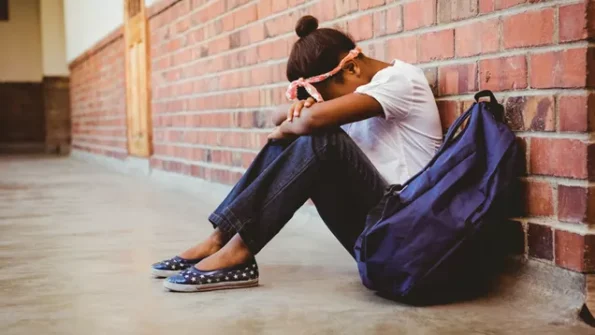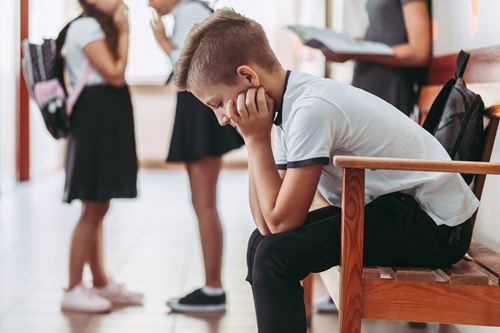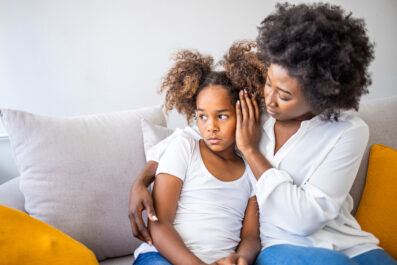Schools are supposed to be a safe space for children to learn, make friends, and dream about the future. But school is also the place where young people are most likely to meet their bully.
According to data published by the Office for National Statistics, 70% of children aged 10-15 who have experienced in-person bullying and 19% who’ve been victims of cyberbullying know the person from school.
But as a foster parent, what can you do about it? From the various types and signs of bullying to addressing it with the school and supporting your young person, join us as we explore bullying and what you can do to make it stop.

What does bullying at school look like?
Bullying can take many forms; sometimes it’s obvious, and other times it can be more subtle. But what they all have in common is the purpose – an intent to intimidate, humiliate, control, or hurt another individual perceived to be less able to defend themselves.
Children can be victims of one type of bullying or a combination of a few. Here they are in more detail:
- Physical: Using violence such as kicking, pulling hair, or damaging another child’s belongings.
- Emotional: Using manipulation, humiliation, criticism or exclusion to erode someone’s self-esteem.
- Verbal: Using words to cause harm, such as name-calling, teasing, insults, and threatening language.
- Social: Using social situations to isolate a person, such as exclusion, embarrassing someone in public, and starting malicious rumours.
- Cyberbullying: Using social media, games consoles and other web-based forums to cause harm, such as sending hateful messages, sharing another child’s images without consent, and spreading rumours.
What are the signs of bullying at school?
According to the Anti-Bullying Alliance, children in care are twice as likely to be a victim of bullying in primary school and four times as likely to be a victim of bullying in secondary school.
Many children in care are living with trauma and complex needs, which can sadly make them a target for bullying. This means, as a foster parent, it’s vital to be aware of the signs that your young person is experiencing bullying, so you can act quickly and mitigate the damage it can have on their well-being.
Here are the telltale signs that your foster child could be a victim of bullying at school:
- Injuries: They have unexplained injuries, such as bruises, cuts, or scratches. They may try to cover them up or become defensive when you ask about them.
- Damaged or missing belongings: Has their brand-new backpack been mysteriously broken? Or their favourite pencil case vanished into thin air?
- Social withdrawal: They may become withdrawn, preferring to stay in their room and refusing to socialise.
- Sudden behavioural changes: They appear stressed, angry, irritable or have outbursts of emotion.
- Changes in eating habits: They might struggle to eat or consume more than usual.
- Sleep issues: They struggle to fall asleep, wake up more frequently during the night, or have nightmares.
- School refusal: They have big feelings about attending school, feign illness, or try to delay going to school by taking longer to wake up, get dressed, and eat breakfast.
- On edge: They jump, hide their phone, or seem upset when they receive a notification on their phone.
- Disclosure: They might tell you they’re experiencing bullying or describe a situation that sounds like bullying.
- Self-harm – In extreme cases, your young person may talk about harming themselves or actually try to harm themselves. In this case, you’ll need to intervene immediately. Mind has lots of guidance and resources about why young people self-harm and how to help them.
How to deal with bullying at school
If you notice any of the above signs that the child in your care could be a victim of bullying, it’s important to act immediately to prevent persistent bullying, which could add to their trauma and impact their healing. Here are some steps you can take to support them.

Talk to your foster child
It may seem like an obvious thing to do, but talking to your young person about bullying isn’t as simple as just asking them ‘Are you being bullied?’
Your young person may not recognise their peer’s behaviour as bullying, or could be worried about the ramifications of letting you know, in case their bully(s) find out and things get worse. They may also struggle to open up about their experiences because their past has taught them that it isn’t safe to do so.
You know the child in your care best, so approach the topic in a way that works for them. For example, you could use open questions like ‘How are things going at school?’ or ‘What are your relationships like with other students?’
Pick an appropriate time to raise the issue, so it feels more natural and less intense for the child, such as while they’re engaged in another activity, such as drawing, playing, or cooking.
If your young person does open up and tells you they’re being bullied, or about a situation that sounds like bullying, reassure them that it’s not their fault and you’ll do everything within your power to stop it from continuing.
Keep a record of bullying
Part of the role of a foster parent is to keep records, which include logging changes in behaviour, mood, and well-being.
You should also record incidents of bullying, whether they’ve been reported to you directly from the child, a witness, or you’ve noticed something yourself.
Your bullying log should include the date and time of each incident, what happened and the impact it has had on your young person. This will serve as essential evidence when you report bullying to the school.
Report bullying to the school
What is the school’s role in supporting looked-after children with bullying?
Schools have a responsibility to safeguard children in care and ensure they receive the support they need to thrive in an educational setting. This includes taking reasonable steps to prevent and tackle bullying.
If the child in your care is experiencing bullying, contact the school and ask for a copy of their anti-bullying policy, which every school is legally required to have. Some schools also provide a link to this policy on their website. It should explain how to report bullying, the investigation process, and the steps the school will take to address the situation.
You can then:
- Report the bullying to the school’s Designated Safeguarding Lead or Designated Teacher for Looked After Children.
- Request a meeting to discuss the situation, where you can explain what has happened, when the incidents occurred, and how it has affected your foster child.
- Ask for a reasonable timeframe for action and agree on when you’ll follow up.
- Escalate the issue if you aren’t satisfied with the outcome, or if the bullying continues or gets worse. You can ask to speak to another senior member of staff or request support from the Virtual School Head to advocate on behalf of your young person.
Remember to make notes of what was said, along with the date, time, and the person you spoke to. You should also inform your supervising social worker and your young person’s social worker, who can help report the issue and make a plan to stop the bullying.
Provide emotional support
For children in care who’ve experienced abuse, neglect, the death of a parent, or another adverse childhood experience, the world can feel like a scary and uncertain place, even without bullying.
But when bullying does happen, it’s even more important that children feel safe, loved and understood at home. They’ll need your emotional support and guidance to ensure bullying doesn’t impact their healing from trauma.
You can help your young person through this difficult time by:
- Reassuring them that it’s not their fault they’re being bullied and making sure they understand the steps being taken to stop it from continuing.
- Encouraging them to make friends outside of school – for example, by attending ISP events where they can share experiences with children who truly understand what it’s like to be in care and living with trauma.
- Limiting their time on devices, such as phones, tablets and laptops, if they’re experiencing cyberbullying, and teaching them how to block and report people to protect themselves from harmful content and messages.
- Using PACE parenting – a therapeutic approach that helps you nurture your relationship with the child in your care, helping them feel safe, understood, and valued just the way they are when they’re at home, away from bullies, in their safe place.
- Helping them personalise their bedroom with things that bring them joy and a sense of peace, so when they get home from school, they can unwind.
- Spending quality time together doing activities they love, such as baking, sports, or watching their favourite TV show.
- Sharing your experiences of bullying or difficult situations so they feel less alone and know that it’s safe to share their thoughts and feelings too.
Lean on ISP’s Therapeutic support
At ISP, our wrap-around support means you’ll never have to face the issue of bullying alone. From therapists and advisory teachers to social workers and fostering advisors, we are here to advocate for your young person’s well-being alongside you.
When you foster with us, you’ll also enrol on our therapeutic pathway training programme, which will give you specialist skills and knowledge to not only care for children living with trauma but to help them heal from their experiences and build a brighter future.
Start your therapeutic fostering journey today
Ready to start your fostering journey? Call us on 0800 0857 989 or submit an enquiry form to take your first step to becoming a therapeutic foster parent and make a real difference in the lives of children and young people in care.






